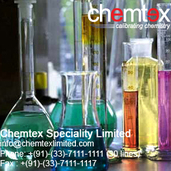 We produce and supply a wide range of Cooling tower biocide or open recirculating water biocides which are widely used for cleaning the closed loop systems to remove the microbial present in the water. The fouling present in the water obstruct the systems from proper functioning and working which can be removed by using these cleaners. Biological growth of algae, slimes and bacterial deposits prevent the normal functioning of the systems. Biocides function in the removal and prevention of spores, fungi, legionella pneumophila bacteria, and many other bacteria etc in cooling tower water. Cooling water biocide is very vital for healthy cooling water treatment for their following benefits:- They avoid plugging of the nozzles with algae and biological foulants. They prevent water borne life taking disease - legionella disease. They improve heat loss because living organisms cause rise in water temperature. Application: Cooling Towers , evaporative condensers, cooling water heat exchangers, adiators, air washers, gear boxes, blow mouling machines, injection mouling machines, housings, d. G. Sets etc. Specification: Form: Liquid / SolidSpecific Gravity: VariablepH: VariableSolubility: Completely/sparingly soluble in waterD osage: Cooling water biocides are normally fed to the re-circulating water by slug dosage directly to the ct sump (basin). The amount of to prevent or remove biofouling depends on the quality of feed water and plant operating conditions. The specific dosage rates will be specified by the csl technical representative. Major Benefits: Prevention of bio-fouling in system avoid plugging of nozzles avoids mic (microbiologically induced corrosion) prevent water borne disease improve the heat loss because living organisms cause rise in temperature of water.
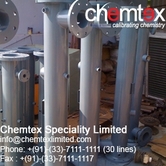 Cleaning Chemicals play a vital role in making the machines and equipments to operate & function properly. Some major industrial coolant & heating machines & equipments go out of work due to the problems like dirt, dust, grease, oil and presence of inorganic and inorganic foulants. These problems are removed by using Chemtex’s offered range of cleaning chemicals while improving the efficiency and functionality of the machines. Due to small negligence and mistake cooling & heating equipments can get crash and be insensitive to work. We implement closed loop system maintenance which is a vital part of HVAC and ACnR maintenance program. this maintenance program can overcome the bigger loses like power loss, system efficiency loss, HTF ( Heat Transfer Fluid) and Refrigerant fouling and degradation, loss of system life, un-scheduled maintenance jobs for de scaling and fixing leaks and bursts due to corrosion. The major area of Closed loop maintenance are being employed in Chemtex Speciality Limited which include Proper system cleaning & passivation after commissioning and corrosion Control. More detail information about above matter is available at www.chiller-chemicals.com.
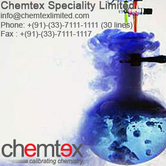 Propylene glycol is used as antifreeze agent and industrial coolant in different industries where contamination with food is possible, de-icing solutions etc. Propylene glycol is generally regarded as safe for use in food. It is used in the industries like food, beverage etc for heat transfer, also used in vehicles. Antifreeze Coolant should be efficient in transferring the heat as well as preventing scale and corrosion. Propylene glycol [HO-CH2-CH(OH)-CH3] is pronounced as pro'puh-leen-gly'col. It is a clear, colorless, slightly syrupy liquid at room temperature. The compound may exist in air in the vapor form though it must be heated or briskly shaken to produce a vapor. It is actually a multi-variant chemical compound. Propylene glycol - in an industrial cooling and heating process terminology is referred as industrial coolant or heat transfer fluid (HTF) or the common fluid that is used in large installations for transporting heat from one place to another. Features :- serves as a solvent
- offers outstanding stability with high flash and boiling points
- reduces the freezing point
- increases the boiling point
- helps to bind and transport other substances (excipient)
- holds and dissolves active ingredients equally in a medium
- connects and stabilizes insoluble fluids (emulsifier)
- attracts/holds water/moisture (hygroscopic)
Usage :- As an emulsification agent in Angostura and orange bitters
- As a moisturizer in medicines, cosmetics, food, toothpaste, shampoo, mouth wash, hair care and tobacco products
- As a carrier in fragrance oil
- To produce polyester compounds
- As a base in deicing solution
- In smoke machines to make artificial smoke for use in firefighters' training and theatrical productions
- As a solvent for food colors and flavorings
- As an ingredient, along with wax and gelatin, in the production of paintballs
- As a wetting agent, used to determine drying time in paints and coatings
A non-toxic substitute of Ethylene Glycol : Propylene Glycol is the replacement of Ethylene Glycol in newer automotive antifreezes and de-icers in aircrafts. Like Ethylene Glycol, Propylene Glycol also has the special physical characteristics of depression of freezing point when mixed with water. It happens due to disruption of hydrogen bonding. Pure water freezes at 0OC. But aqueous solution of Propylene Glycol (10% by weight) has a freezing point of -3OC. 30% by weight aqueous solution of Propylene Glycol freezes at -12OC and a 60% by weight Propylene Glycol and water mixture can further lower down this freezing point to -51OC. Why Glycol turned into red color ? Because of the extensive corrosion & rust in the system metal makes the glycol turn reddish in color. At this point the glycol is fouled with iron contaminants that increase the glycol degradation rate. It is important to add corrosion inhibitor to the glycol system to avoid such degradation of glycol. Application Areas : Beverages & Juices, Breweries & Distilleries, Packaged Food Freezing, Canneries & Preservers, Fish Processing Units, Pharmaceutical & Bulk Drugs, Poultry Processing Industry, Thermal Storage System, Heating and Cooling Systems, Snow Melting and Refrigeration, Ice Skating Rinks, Vegetable Oil Industry, Ice Manufacturer, Cold Storage Systems etc. Product Physio-Chemical Data :- Form and Appearance - Clear, colorless liquid
- Assay as Propylene Glycol - 99.8%
- Specific Gravity - 1.04 (approx.)
- Molecular Wt. - 76.0548 gm/mol
- Solubility in Water - 100%
Handling Measures, Precaution & Storage : Propylene Glycol is slightly hygroscopic & the storage temperature is not critical, it must be stored under conditions so that contamination with water and adsorption of moisture are prevented. It should be noted however for product quality reasons the storage temperature should not go above 40°C. At below freezing temperatures the product viscosity might become too high for transfer from the storage containers with the pumps available. PG is a stable chemical and is not expected to deteriorate significantly with time provided if it is stored as indicated. The drums should be stored in dry condition, better to use the original drums rather than the other drums and if the drums are opened then it must be closed tightly at unused situation. The chemical can be stored up to 6 months.
 A chiller is a machine that removes heat from a liquid via a vapor-compression or absorption refrigeration cycle. This liquid can then be circulated through a heat exchanger to cool air or equipment as required. Cooling towers are heat removal devices used to transfer process waste heat to the atmosphere. Cooling towers may either use the evaporation of water to remove process heat and cool the working fluid to near the wet-bulb air temperature or in the case of closed circuit dry cooling towers rely solely on air to cool the working fluid to near the dry-bulb air temperature. Biocides and MicroBiocides are chemicals that prevent and eradicate unwanted biological fouling from the system. Biocides are of various nature such as oxidizing, non-oxidizing, cationic, anionic etc. Biological Fouling or Biofouling is the undesirable accumulation of micro-organisms, algae and diatoms, plants, and animals on surface, pipelines and heat-exchangers of cooling systems. Bio-fouling can be of aerobic (that require oxygen) or anerobic (that don't require oxygen) organisms. In general the former is found in Cooling Towers and the later in closed circuit systems. Another very important reason for using Cooling Tower Micro Biocides in cooling towers is to prevent the growth of Legionella, including species that cause legionellosis or Legionnaires' disease, most notably L. pneumophila, or Mycobacterium avium. The various Legionella species are the cause of Legionnaires' disease in humans and transmission is via exposure to aerosols—the inhalation of mist droplets containing the bacteria. Common sources of Legionella include cooling towers used in open recirculating evaporative cooling water systems, domestic hot water systems, fountains, and similar disseminators that tap into a public water supply. Micro biocides function in eradication of sulfate reducing bacteria, aerobic and anaerobic bacteria that are formed and found in Cooling Tower Water.Micro Biocides are very vital for Closed and Open Circuit Cooling Water Treatment. TCF (Totally Chlorine Free) micro biocides are compatible with heat transfer fluids (HTF) and can be used without any fear of corrosion of chlorine addition to the system or depletion or degradation of HTF and corrosion of PHE (plate type heat exchangers) Chemtex’ s Closed loop Micro biocide surpasses the performance of other such less effective closed loop treatment chemicals (such as Nalco 7330, Nalco 77352NA etc.) Application: Engine Jacket, Chiller Water Circuit, Glycol Brine System, Hot Water Circuit, Engine Coolant, Process chilling and heating etc. Specification:- Chemical Type : Organic/Inorganic Chemical Compound (TCF)
- Form : Liquid
- Specific Gravity : Ranges from 1.0 – 1.2 depending upon product
- Solubility : Completely Soluble in Water
Dosage: The amount of Closed Loop Biocide required to inhibit or remove bio fouling depends on the type of system, application, re-circulating fluid property and plant operating conditions. The specific dosage rates will be specified by the CSL technical representative. Major Benefits:- Prevention of Bio-fouling of system
- Avoid plugging of nozzles
- Avoids MIC (Microbiologically Induced Corrosion)
- Prevent Water Borne Diseases
- Improve heat loss because living organisms cause rise in temperature of water
- Does not add chloride to the system
To prevent the growth of virus bacteria in cooling tower, Chemtex’s Closed Loop Chiller Water Non-Oxidizing Microbiocide is the best solution. To know more, mail to [email protected] or call to +91-33-71111111. Not only about the above chemical but also the details of other type of industrial chemicals like inhibited glycols, water treatment chemicals, boiler chemicals, ro chemicals, cooling chemicals, heat transfer fluids, Acid inhibitors (Rodine Type), cleaning chemicals, descaling chemicals etc can be found in above contact details.
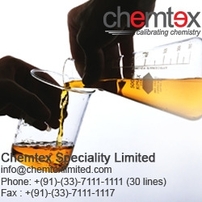 Orange Colored Inhibited Mono Ethylene Glycol General Name: Pre-Inhibited Ethylene Glycol based Heat Transfer Fluid - Orange Color Product Description: Orange colored Inhibited Ethylene Glycol is used as an industrial coolant, antifreeze heat transfer agent. The inhibitor package is designed to protect brass, copper, solder, steel, cast iron, aluminum and other metals commonly found in the industrial cooling and heating systems. The effectiveness of Inhibited Ethylene Glycol in preventing corrosion has been proven in extensive laboratory and in actual service tests. Using Inhibited Ethylene Glycol for heat transfer applications instead of brine solutions or uninhibited ethylene glycol reduces maintenance costs and improves heat transfer efficiency. Application Areas:- Beverages & Juices
- Breweries & Distilleries
- Thermal Storage System
- Pharmaceutical & Bulk Drugs
- Snow Melting & Refrigeration
- Oil Refineries
- Automobile Coolant Manufacturers
- Ice Skating Rinks
- Rubber Industry
- Cold Storage Systems
- Cold Rolling Mills
- Milk and Dairy Industry
- Meat Processing Industry
- Solvent Extraction Units
- Vanaspati & Vegitable Oils
- Industrial Coolants
Product Physio-Chemical Data:- Form and Appearance : Orange colored liquid
- Mono Ethylene Glycol : 97% ± 0.5%
- Inhibitor package and water : 3.5% ± 0.5%
- pH of solution : 10.0 ± 1.0
- Solubility in Water and Glycol : 100%
Orange Colored Inhibited Ethylene Glycol is used as heat transfer agent in food, beverage or brewery industries, there lays a possibility of contamination even though Ethylene Glycol is harmless to our health up to a certain level. But to keep ourselves on the safer side of the problem, something has to be done to detect the leakage of Glycol from the system. But we are fortunate enough that it had already done. Chemtex’s offered a perfect blend of Inhibited Ethylene Glycol and a colored leak detecting media. This media turns the Glycol solution to blue or orange or red colored solution. So, whenever there is any leakage from Glycol systems, it will be visible during the daylight and even in the night time due to its color. Handling Measures, Precaution & Storage:- Orange colored Inhibited Ethylene Glycol is toxic and must be handled with all necessary precautions. Proper human safety products such as Splash goggles, lab coat, vapor respirator, gloves and boots should be worn while handling and applying chemicals.
- Splashes on skin should be washed off with water immediately. In case of splashing into the eyes, flush it with fresh water and obtain medical attention. It should not be injected.
Chemtex has the full range of Inhibited Glycol either it is Inhibited Ethylene Glycol or Inhibited Propylene Glycol. We are offering both types of Inhibited Glycol. Inhibited Ethylene Glycol is mainly for industrial use except any types of food or beverage or dairy etc. related industries where contaminations of Inhibited Glycol with food or drinks products are possible. In those special cases we have Inhibited Propylene Glycol which especially designed for food grade to use in food products related or manufacturing industries. For Orange Colored Inhibited Propylene Glycol contact us at +91-33-7111-1111 or [email protected].
_ Nitrite based Corrosion Inhibitors for chilled water systems is a multi-metal corrosion inhibitor based on nitrite and other organic compounds with special yellow metal corrosion inhibitor and anti-scaling agent that helps to prevent scale deposition or also removes adhering loose scale deposits from the heat transfer fluid system.
There are several disadvantages for not treating the closed circuit water and in long run it can create troubles for the system operator. The corrosions caused by chiller water, Mono Ethylene Glycol or Brine can cause system leakage in PHE (Plate Heat Exchanger) and AHU (Air Handling Unit). Corrosion can also cause plugging and clogging of tubes and thus reduce flow rate. This will affect the heat transfer rate and will force the system to reduce heat transfer efficiency. This way the system needs regular descaling that incurs shutdowns, leads to additional costing for labor and wastage of time.
“Scale” is a hard deposit of inorganic material on heat transfer surfaces. This is caused by gradual precipitation of mineral particles in water on the surface. During the evaporation of water in a evaporative condenser, pure water vaporizes out and the dissolved solid materials concentrate in the remaining water on the surface. The solids will then settle in pipelines or on heat exchange surfaces, where it frequently solidifies into a relatively soft, amorphous scale.
Next to scale, the next most important concern is the prevention of “corrosion”.
Corrosion is defined as the destruction or loss of metal through chemical or electrochemical reaction with its surrounding environment or material. Mild steel is a most commonly used metal in the cooling water system. But this metal is most susceptible to corrosion. However in some waters and in presence of dissolved gases, such as H2S or NH3, the corrosion to these metals is more severe.
Common problems arising from corrosion are reduction in heat transfer and water flow resulting from a partial or complete blockage of pipes, valves, strainers, etc. Also, excessive wear of moving parts, such as pump, shaft, impeller and mechanical seal, etc. may resist the movement of the equipment. Hence, thermal and energy performance of heat exchange may degrade.
The water treatment in closed system is thus not very critical. Once the initial volume is chemically treated, the quality of the circulating fluid needs to be monitored on a regular basis and additional chemicals added as required to maintain recommended residual concentrations of treatment chemicals.
Most closed-loop water systems use a sodium nitrite based inhibitor for corrosion control and a biocide to prevent biological contamination. These inhibitors will protect both the ferrous and non-ferrous materials in your piping system.
The major advantages of using nitrite based corrosion inhibitor are as follows:-
- Removes dissolved oxygen by converting the nitrite to nitrate.
- Negligible loss of metal or corrosion.
- Excellent heat transferability and flow rate.
- No need of descaling closed circuit equipments.
- Long and extended life of Water without fouling.
Application: Engine Jacket Cooling or heating system, Chiller Water Circuit, Glycol Brine System, Hot Water or steam Circuit, Engine Coolant, Process chilling and heating system etc.
Dosage: Nitrite based Corrosion Inhibitor for Water and Glycol Brine is normally fed continuously to the re-circulating closed system by injection dosing pump or dosed to the expansion tank. The amount of Nitrite based Corrosion Inhibitor for Water and Glycol Brine to inhibit corrosion depends on the type of system and plant operating conditions. The specific dosage rates will be specified by the Chemtex's technical representative.
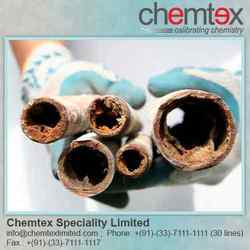
_ Chemtex’s MEG Corrosion Inhibitor is a specially formulated chemical additive designed to prevent corrosion in multi-ways. It treats the surfaces of the metal making them less susceptible to corrosion. It buffers the organic acids formed as a result of glycol oxidation. Inhibited glycol based heat transfer fluids provides corrosion protection without reducing system’s heat transfer efficiency. It is very important to use inhibitor in glycol system to prevent degradation of glycol. Glycol in presence to heat and air degrades into five organic acids namely: Glycolic Acid, Glyoxalic Acid, Formic Acid, Carbonic Acid & Oxalic Acid. Metal acts as catalyst in un-inhibited glycol solution for the formation of these acids, which then chemically attacks and corrodes system. Also available Pre Inhibited Mono Ethylene Glycol and normal Mono Ethylene Glycol. Chemtex’s MEG ( Ethylene Glycol) Brine Corrosion Inhibitor is a specially formulated chemical compound designed to prevent corrosion in multi-ways. MEG ( Ethylene Glycol) Brine Corrosion Inhibitor treats the surfaces of the metal making them less susceptible to corrosion. MEG (Ethylene Glycol) Brine Corrosion Inhibitor buffers the organic acids formed as a result of glycol oxidation. Inhibited (MEG) glycol based heat transfer fluids provides corrosion protection without reducing system’s heat transfer efficiency. It is very important to use corrosion inhibitor in glycol system to prevent degradation of glycol. MEG in presence to heat and air degrades into five organic acids viz., Glycolic Acid, Glyoxalic Acid, Formic Acid, Carbonic Acid & Oxalic Acid. Metal acts as catalyst in un-inhibited glycol solution for the formation of these acids, which then chemically attacks and corrodes system. Glycol turns Red. What does this indiate? Due to the high corrosion in the HTF system, the rust in the system metal makes the glycol turn reddish in colour. At this point the glycol is fouled with iron contaminants which increase the glycol degradation rate. It is very important to add corrosion inhibitor to the glycol system to avoid such degradation of glycol. Application: Mono Ethylene Glycol System (MEG) Specification: o Chemical Type: Organic Chemical Additive o Form: Liquid o Freezing Point: Very low (Supercools) o VOC: Nil o Solubility: Completely Soluble in Glycol & Water Dosage: The amount of MEG ( Ethylene Glycol) Brine Corrosion Inhibitor required to inhibit corrosion depends on the type of system, application, brine concentration and plant operating conditions. The specific dosage rates and method will be specified by the Chemtex's technical representative. Major Benefits: 1. Negligible loss of metal or corrosion. 2. Excellent heat exchange and flow rate. 3. Long and extended life of glycol without fouling. 4. Avoids heat exchangers from leaking such as PHEs. 5. Maintains the anti-freezing properties of MEG. 6. Does not form sludge as in case of other mere pH buffers used in MEG. Team Chemtex is proud to be a trusted business partner of its valued customers, offering excellent technical support and best supply chain management solutions for both domestic & overseas trade.Today, the organizations choose Chemtex for our integrity, transparency, our observance for high quality standards and our commitment to customer value. In this site we have focused on our prime business area - Heat Transfer Fluids, PCMs and Eutectic Solutions. The industry is ever growing at an unmatched pace of about 20% - 30% every year.Apart from this, Chemtex offer wide range of speciality chemicals, including Water Treatment Chemicals, Chiller Chemicals, Corrosion Inhibitors, disinfectants for food and beverage industry, cleaners, degreasers, plant maintenance chemicals etc. Chemtex has mastered the ways and means of doing business better with a farsighted combination of vision, creative thinking, technology, logistics & management. In all that we do at Chemtex, we are guided by our sole mission statement - 'The Chemtex Way'. Doing business this way has paid us very rich dividends. Chemtex has the full range of Inhibited Glycol either it is Inhibited Ethylene Glycol, Inhibited Propylene Glycol. We are offering all types of corrosion inhibitors, mainly for industrial use. For mono ethylene glycol brine corrosion inhibitor, contact to [email protected] or +91-33-71111111 
_ Inhibited Propylene Glycol 60% Premix is a 60% propylene glycol mixed with balanced water and inhibitor packages ready to use industrial coolant. It is available in various color options and pack sizes. This product is used as an industrial antifreeze heat transfer fluid.
Product Description:
60% Premix Inhibited Propylene Glycol is used as an industrial coolant, antifreeze heat transfer agent. The inhibitor package is designed to protect brass, copper, solder, steel, cast iron, aluminum and other metals commonly found in the industrial cooling and heating systems. 60% pre-inhibited propylene glycol mixture industrial coolant outperforms dowtherm, dowcal, norkool range of pre-inhibited industrial coolants.
Both inhibited propylene glycol and inhibited ethylene glycol have similar biodegradability and will eventually break down into nontoxic byproducts. Antifreeze picks up heavy metals such as lead during use in the engine. Therefore, both ethylene glycol and propylene glycol antifreezes should be returned to a recycling center to minimize harmful effects on our environment after use. Spills should be cleaned up immediately.
Inhibited Ethylene glycol is more toxic than Inhibited propylene glycol. Ingesting a small amount of ethylene glycol is far more dangerous for small children or animals, for example, than ingesting a small amount of propylene glycol. Take appropriate steps to prevent the ingestion of either ethylene or propylene glycol, as well as new or used engine coolants containing these glycols.
Application Areas:
• Beverages & Juices
• Breweries & Distilleries
• Diesel Engine Coolant
• Radiator Coolant
• Automobile Coolant Manufacturers
• Oil Refineries
• Thermal Storage System
• Heating and Cooling Systems
• Snow Melting and Refrigeration
• Rubber Industry
• Ice Manufacturer
• Cold Rolling Mills
Product Physio-Chemical Data:
Form and Appearance : Clear, colorless liquid
Asay as Propylene Glycol : 60.0% ± 0.5%
Inhibitor package and water : Balance
pH of solution : 9.5 ± 1.0
Solubility in Water and Glycol : 100%
Maximum Operating Temperature : 107°C (225°F)
Freezing Point : -51°C (-60°F)
Handling Measures, Precaution & Storage:
60% Premix Inhibited Propylene Glycol is non-toxic and can be handled easily. However, proper human safety products such as Splash goggles, lab coat, vapor respirator, gloves and boots should be worn while handling and applying chemicals.
Splashes on skin should be washed off with water immediately. In case of splashing into the eyes, flush it with fresh water and obtain medical attention. It should not be injected.
Chemtex has the full range of Inhibited Glycol either it is Inhibited Ethylene Glycol, Inhibited PG or 60% Premix Inhibited Propylene Glycol. We are offering all mentioned types of Inhibited Glycol. Inhibited EG is mainly for industrial use except any types of food or beverage or dairy etc. related industries where contaminations of Inhibited Glycol with food or drinks products are possible. For Blue Colored Inhibited Propylene Glycol contact us at +91-33-7111-1111 or [email protected].
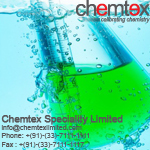 Form and Appearance : Bright Green Colored Liquid General Name : Bright Green Colored Inhibited Propylene Glycol based Heat Transfer Fluid
Brine or glycol coloring agent is a unique leak detecting instrument that is very easy and economical to use. Small amount of ALSTA GLO added to the system turns the whole glycol, brine or coolant solution to turn bright florescent green color. This color is unique in the way that it starts glowing in presence of UV light.
Now have comes two questions in mind - Why? And How? Especially when Propylene Glycol or Inhibited Propylene Glycolis used as heat transfer agent in food, beverage or brewery industries, there lays a possibility of contamination even though Propylene Glycol is harmless to our health up to a certain level. But to keep ourselves on the safer side of the problem, something has to be done to detect the leakage of Glycol from the system. But we are fortunate enough that it had already done. Chemtex’s continuous innovation blesses us with a perfect blend of Inhibited Mono Ethylene Glycol or Inhibited Propylene Glycol and a colored leak detecting media. This media turns the Glycol solution to fluorescent green or orange colored solution. So, whenever there is any leakage from Glycol systems, it will be visible during the daylight and even in the night time due to its fluorescent color.
The leak detection dye also has a very special feature that can make it very easy to detect small pinhole punctures or leakages at its very nascent stage before it takes a shape of a large puncture or burst and cause production and maintenance havoc. This special mechanism of the Brine leak detection dye is its ability to glow in the dark in presence of UV light. However, the bright green color of Colored Glycol remains easily detectable whenever or wherever there is a leakage and thus helps us to avoid unwanted contamination of Ethylene Glycol or Propylene Glycol especially with food items and other chemicals used in the system.
Description :
The effectiveness of Green Colored Inhibited Propylene Glycol in preventing corrosion has been proven in extensive laboratory and in actual service tests. Using Inhibited Propylene Glycol for heat transfer applications instead of brine solutions or uninhibited propylene glycol reduces maintenance costs and improves heat transfer efficiency.
Inhibited Propylene Glycol and Green Colored IPG are used as an industrial coolant, antifreeze heat transfer agent. The inhibitor package is designed to protect brass, copper, solder, steel, cast iron, aluminum and other metals commonly found in the industrial cooling and heating systems.
Application Areas :
- Beverages & Juices
- Thermal Storage System
- Cold Storage Systems
- Breweries & Distilleries
- Dairy & Ice Cream
- Packaged Food Freezing
- Heating and Cooling Systems
- Snow Melting and Refrigeration
- Ice Skating Rinks
- Vegetable Oil Industry
- Ice Manufacturer
- Fish Processing Units
- Pharmaceutical & Bulk Drugs
- Poultry Processing Industry
Product Physio-Chemical Data :- Form and Appearance : Bright Green Colored Liquid
- Propylene Glycol : 96.5% ± 0.5%
- Inhibitor package and water : 3.5% ± 0.5%
- pH of solution : 10.0 ± 1.0
- Solubility in Water and Glycol : 100%
- Maximum Operating Temperature (°C) : 121
- Freezing Point (°C) : -65
Handling Measures, Precaution & Storage:
Inhibited Propylene Glycol / Bright Green Colored Inhibited Propylene Glycol is non-toxic and can be handled easily. However, proper human safety products such as Splash goggles, lab coat, vapor respirator, gloves and boots should be worn while handling and applying chemicals.Splashes on skin should be washed off with water immediately. In case of splashing into the eyes, flush it with fresh water and obtain medical attention. It should not be injected.
Inhibited Propylene Glycol is used in chillers, glycol systems, boiler systems, solar panels, and many other water based systems. Bright Green Colored IPG is a special kind of Inhibited Propylene Glycol which posses very special characteristics that detects any type of leakage of inhibited glycol due to the bright green color and it is usually produced from either propylene oxide or glycerol.
Chemtex has the full range of Inhibited Glycol either it is Inhibited Ethylene Glycol, Inhibited Propylene Glycol or Green Colored Inhibited Propylene Glycol. We are offering all mentioned types of Inhibited Glycol. Inhibited Ethylene Glycol is mainly for industrial use except any types of food or beverage or dairy etc. related industries where contaminations of Inhibited Glycol with food or drinks products are possible. In those special cases we have Inhibited Propylene Glycol which especially designed for food grade to use in food products related or manufacturing industries. For Bright Green Colored Inhibited Propylene Glycol contact us at +91-33-7111-1111 or [email protected]
 _General Name : Pre- Inhibited Propylene Glycol based Heat Transfer Fluid Product Description: Inhibited Propylene Glycol is used as an industrial coolant, antifreeze heat transfer agent. The inhibitor package is designed to protect brass, copper, solder, steel, cast iron, aluminum and other metals commonly found in the industrial cooling and heating systems. The effectiveness of Inhibited Propylene Glycol in preventing corrosion has been proven in extensive laboratory and in actual service tests. Using Inhibited Propylene Glycol for heat transfer applications instead of brine solutions or uninhibited propylene glycol reduces maintenance costs and improves heat transfer efficiency. Application Areas:- Beverages & Juices
- Breweries & Distilleries
- Dairy & Ice Cream
- Packaged Food Freezing
- Fish Processing Units
- Pharmaceutical & Bulk Drugs
- Poultry Processing Industry
- Thermal Storage System
- Heating and Cooling Systems
- Snow Melting and Refrigeration
- Ice Skating Rinks
- Vegetable Oil Industry
- Ice Manufacturer
- Cold Storage Systems
Product Physio-Chemical Data:Properties : Description (Typical Value)Form and Appearance : Clear, colorless liquidPropylene Glycol : 96.5% ± 0.5%Inhibitor package and water : 3.5% ± 0.5%pH of solution : 10.0 ± 1.0Solubility in Water and Glycol : 100%Maximum Operating Temperature (°C) : 121Freezing Point (°C) : -65 Handling Measures, Precaution & Storage: Inhibited Propylene Glycol is non-toxic and can be handled easily. However, proper human safety products such as Splash goggles, lab coat, vapor respirator, gloves and boots should be worn while handling and applying chemicals. Splashes on skin should be washed off with water immediately. In case of splashing into the eyes, flush it with fresh water and obtain medical attention. It should not be injected. Chemtex Speciality Limited is one of the leading international ISO 9001:2008 certified companies dedicated to provide its clients Inhibited Propylene Glycol blended with leading edge technologies. Normal Propylene Glycol may corrode the system metals like aluminum, cost iron, copper, brass, solder etc. which are used in internal combustion engines and other heat transfer applications, such as HVAC chillers and solar water heaters. But like each and every time Chemtex has a one stop solution for the corrosion problem. You don’t have to think about it twice. You don’t need to add Corrosion Inhibitors to prevent system metal corrosion. Leave it on Chemtex. Our Inhibited Propylene Glycol will draw the finishing line to all these problems and your system will perform like never before. Inhibited Propylene Glycol is used in chillers, glycol systems, boiler systems, solar panels, and many other water based systems. It is usually produced from either propylene oxide or glycerol. For Chemtex’s Inhibited Propylene Glycol contact us at +91-33-7111-1111 or [email protected]. Propylene Glycol is the replacement of Ethylene Glycol in newer automotive antifreezes and de-icers in aircrafts. Like Ethylene Glycol, Propylene Glycol also has the special physical characteristics of depression of freezing point when mixed with water. It happens due to disruption of hydrogen bonding. Pure water freezes at 0OC. But aqueous solution of Propylene Glycol (10% by weight) has a freezing point of -3OC. 30% by weight aqueous solution of Propylene Glycol freezes at -12OC and a 60% by weight Propylene Glycol and water mixture can further lower down this freezing point to -51OC. Chemtex has the full range of Inhibited Glycol either it is Inhibited Ethylene Glycol or Inhibited Propylene Glycol. We are offering both types of Inhibited Glycol. Inhibited Ethylene Glycol is mainly for industrial use except any types of food or beverage or dairy etc. related industries where contaminations of Inhibited Glycol with food or drinks products are possible. In those special cases we have Inhibited Propylene Glycol which especially designed for food grade to use in food products related or manufacturing industries.
|







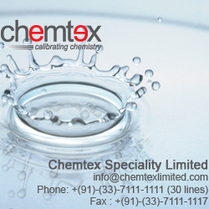


 RSS Feed
RSS Feed